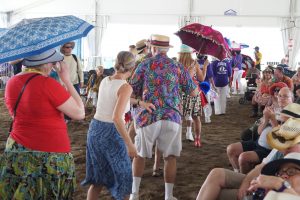I’ve just returned from a field trip to the New Orleans Jazz and Heritage Festival. True, New Orleans is not in Europe, but other than that the event ticks all the boxes of our CHIME acronym: Cultural Heritage, Improvised Music, and Festivals. Spread out over two extended weekends, Jazz Fest, as the event is commonly referred to, is fully focused on celebrating New Orleans’ and Louisiana’s cultural heritage, both tangible and intangible. Of course, the most obvious local music heritages are jazz and NOLA brass band culture, and despite the usual complaints that the acts on the main stages are not jazz but something else (Pearl Jam, Steely Dan, Red Hot Chili Peppers), there are many concerts on the smaller stages that are dedicated to musics that live up to the festival’s epithet, including jazz, brass band, zydeco, cajun, blues and gospel.
The main stages trumpet the names of the main sponsors (Acura Stage), yet other stages carry more descriptive names (Blues Tent, Gospel Tent), while yet others emphasize the connection with local traditions: Jazz and Heritage Stage, Congo Square Stage, Lagniappe Stage (the local term “lagniappe” refers to a gift or an extra), and Sheraton New Orleans Fais Do-Do Stage (a “fais do-do” is a Cajun dance party). The festival also exhibits folk crafts, arts and traditions in its Louisiana Folklife and Native American Villages. It celebrates local cuisines, too, for instance at the Grandstand, which “gives Festgoers a chance to take an intimate look at the vibrant culture, cuisine and art of Louisiana.” In addition, the festival has become a tradition itself, and many Festgoers have become regulars, who have developed their own traditions and rituals on the festival grounds.
Helen Regis and Shana Walton discuss in “Producing the folk at the New Orleans Jazz and Heritage Festival” the many tensions that center around questions of ownership, agency, race and authenticity. In Roll with it: Brass Bands in the Streets of New Orleans Matt Sakakeeny points up similar tensions, specific to the brass bands that perform at Jazz Fest.
Of special interest to me was the second-lining that takes place at Jazz Fest. Second-line culture in New Orleans centers around the many active brass bands in the city and the so-called Social Aid and Pleasure Clubs (SA & PCs), societies founded as black self help organizations. SA & PCs parade in their annual processions and at funerals. In a parade, the first line consists of the club members and the brass band. The bystanders who join in after the first-liners form the second line. Regis (2001, 13) points out that the term second line is ambiguous, as it refers to “multiple dimensions of the same phenomenological reality. It refers to the dance steps, which are performed by club members and their followers during parades. … [but] the term second line often is used to refer to the overall parade, including club, band and followers.”
SA & PCs parade at the festival grounds as part of the programming, but the local brass bands can mostly be heard at the Jazz & Heritage Stage and the Economy Hall Tent. Here too, second-line culture is put on display, but with the brass band on stage rather than leading the parade. As soon as the band hits an up-tempo song, the regulars at the Fest spring to their feet, open their umbrella’s–often self adorned–and start parading the tent, moving to the music. There is little here that resembles an authentic second-line parade in one of the city’s communities, yet it is as close as many of the Festgoers will ever get to this vibrant culture. Interestingly, these tent parades have become a festival tradition in themselves, and it is clear that to the participants the practice is an authentic expression. The New Orleans Jazz and Heritage Festival celebrates local traditions, but has become a locus of newly created and invented traditions itself.
Festgoers second-line in the Economy Hall Tent to the music of the Paulin Brothers Brass Band
Bibliography
Hobsbawm, Eric and Terence Ranger, eds. 1983. The Invention of Tradition. Cambridge University Press.
Jones, David M., (director). 1995. New Orleans Jazz Funerals from the Inside. Documentary film. DMJ Productions, DMJ1018.
Regis, Helen A. 1999. “Second Lines, Minstrelsy, and the Contested Landscapes of New Orleans Afro-Creole Festivals.” Cultural Anthropology, Vol. 14, No. 4 (Nov.): 472–504.
Regis, Helen A. 2001. “Blackness and the Politics of Memory in the New Orleans Second Line.” American Ethnologist, Vol. 28, No. 4 (Nov.): 752–777.
Sakakeeny, Matt. 2010. “‘Under the Bridge’: An Orientation to Soundscapes in New Orleans.” Ethnomusicology Vol. 54, No. 1: 1-27.
Sakakeeny, Matt. 2011. “Jazz Funerals and Second Line Parades.” KnowLA Encyclopedia of Louisiana. David Johnson, ed. Louisiana Endowment for the Humanities. 3 February.
Sakakeeny, Matt. 2011. “New Orleans Music as a Circulatory System.” Black Music Research Journal, Vol. 31, No. 1 (Spring): 291–325.
Sakakeeny, Matt. 2013. Roll with It: Brass Bands in the Streets of New Orleans. Durham: Duke UP.
